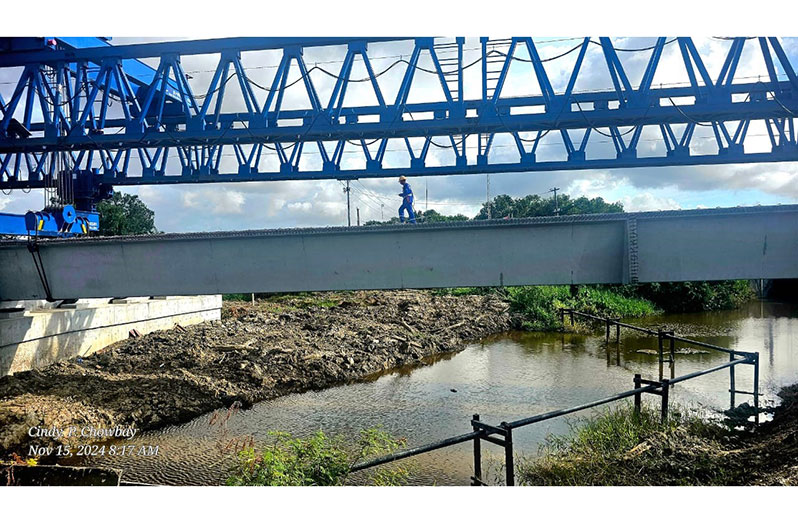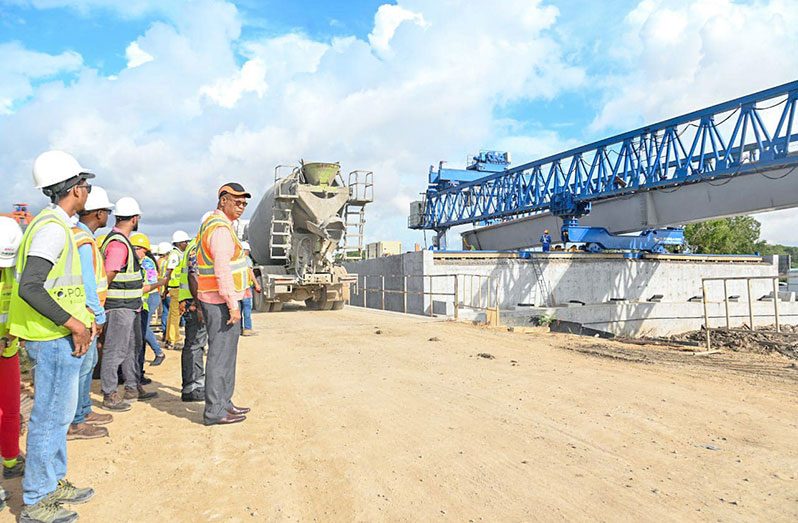bridge set to be completed by March 2025 deadline
IN a significant step toward the completion of the New Demerara River Bridge, Minister of Public Works, Bishop Juan Edghill, on Friday, witnessed the first of 472 precast girders for the landmark project. This marks a new phase in the bridge’s construction, signalling further advancement in Guyana’s infrastructural development.
The girder launcher has a capacity exceeding the girder’s weight, ensuring efficient operations.
Moving at a speed of just two kilometres per hour allows for precise placement.
Once the first eight girders are installed, the launcher will be repositioned and the process will repeat until all girders, including those for the central span, are in place. The installation of the first eight girders is expected to take about a day.
Precast girders are horizontal beams designed to support the bridge deck and bear the weight of traffic, making their installation a crucial milestone in the construction process. Minister Edghill attended the launch on the western end of the bridge and addressed the media, emphasising the significance of that phase.

“This is another substantial advancement in the bridge’s construction,” Minister Edghill remarked. “Each phase of construction brings us closer to realising the bridge, which will not only improve connectivity but also contribute to regional economic prosperity.”
The minister also shared that some key elements of the cable-stayed bridge have already arrived in the country, with the remainder expected soon. With an overall project completion rate of 75%, he confirmed that the project remains on track for its March 2025 deadline, with no major setbacks reported thus far.
“The challenges that could have affected the delivery of the bridge on time, particularly the shipping of materials, have been successfully addressed,” said Edghill. “We are operating 24 hours a day, and progress has been continuous.”
The minister acknowledged the efforts of the 800+ workers involved in the project, noting that the construction company is fully mobilised to meet the deadlines. The only potential challenge, he pointed out, would be ensuring the workforce keeps pace with the demanding schedule.
By the end of December, the bridge’s two towers, currently standing at 73 metres, are expected to rise to 112 metres. Minister Edghill expressed his gratitude to the contractors, consultants, and his team at the Ministry of Public Works for their round-the-clock commitment to the project’s success.
Patrick Thompson, the Chief Transport Officer, elaborated on the technical aspects of the girder installation. The first girder was connected to the girder launcher, which had been positioned on the bridge’s first two piers. He explained that each set of piers would be connected by eight girders, and the launcher would be moved in stages to install the remaining girders until the bridge’s middle span is reached.
“The process to launch all eight girders could take a day, with the launcher moving at just 2 kilometres per hour,” Thompson explained, highlighting the intricacy of the process.
The US$260 million New Demerara River Bridge, being executed by China Railway Construction Corporation Limited and supervised by Italian firm Politecnica, will significantly enhance transportation infrastructure in the region. Unlike the existing Demerara Harbour Bridge, which restricts vehicle speed to 32 km/h, the new bridge will support vehicles of all sizes with a speed limit of 80 km/h. The new bridge will be constructed six metres above the water, allowing uninterrupted passage for vessels beneath.
Additionally, the new bridge will not require retraction like the current one, greatly improving the daily commute for residents on the East Bank, West Bank, and West Coast of Demerara, ensuring smooth and uninterrupted transportation for years to come.




.jpg)









